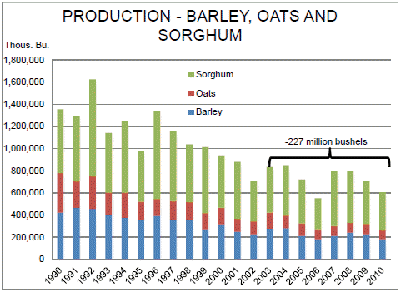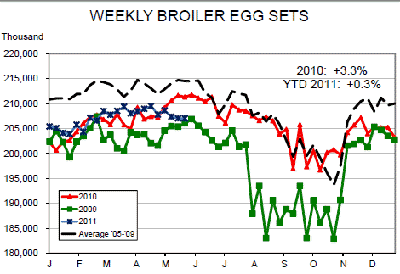



CME: Output of Sorghum, Barley & Oats Falling
US - Output levels for sorghum, barley and oats have been falling for many years, write Steve Meyer and Len Steiner.In response to our discussion yesterday regarding dried distillers grains with solubles (DDGS), the major by-product of corn ethanol production, our friend Dr. Tom Elam of FarmEcon LLC sent a note urging us to also consider the other three major feed grains – grain sorghum, barley and oats. Dr Elam wrote: 'Corn acres have grown at the expense of the other three feed grains, and not by a little bit. When you look at total feed grains + DDGS feed use the trend is down, not flat.' The authors says they were aware of this impact of increasing corn acres but did not have the space to discuss the issue in the previous edition – so they address the topic now.
As can be seen in the graph below, the output levels for these three 'other feed grains' has been falling for many years. Barley output in 2010 was less than half the level of 1990. Oats output was only 27 per cent as large as it was in 1990 and sorghum production was 40 per cent lower than in 1990. Total sorghum, oats and barley output in 2010 was only 45 per cent as large as the production of those three grains in 1990.

And, while the rate of decline has slowed, the acreage and production levels for these three grains have fallen since 2003 – the beginning of the nine-year period that they mentioned in the previous DLR as being a period of flat corn + DDGS availability for livestock and poultry feeders. In fact, the total acres planted to these crops has fallen from 19.365 million in 2003 to just 11.414 million in 2010. Production has fallen from 833.885 million bushels to only 606.863 million bushels during that same time period. USDA has projected that the total acres planted to these three crops will grow this year by 22,000 to 11.436 million.
Will the meat/poultry complex finally see a respite from the production and price pressure of the US broiler sector soon? Recent USDA data for the number of broiler-type chicken eggs placed in incubators certainly suggest that is possible. Egg sets have been between 0.3 per cent and 2.2 per cent lower than one year ago over the past four weeks. It is the first string of four weeks in which egg sets have fallen relative to one year earlier since the last two week of 2008 and first two week of 2009. After robust growth of 3.3 per cent in 2010, total US egg sets are up only 0.3 per cent year-to-date in 2011.

These lower sets should show up as lower placements in the next two to three weeks and those placements should show up as fewer birds slaughtered five to seven weeks past that point. The exact timing depends on which type of bird is seeing reduced output. Today's 'meat chickens' are divided between two pretty distinct sub-sectors – the small birds that are primarily processed into chicken parts for food-service and the big birds (7-9lbs) that are boned out to produce boneless chicken products. Heavier weights imply a changing product mix rather than longer feeding as is frequently the case in the pork and beef industries.
A reduction in broiler output would be good news for everyone, say the authors, including the companies producing broilers. Retail chicken prices have held very close to year-ago levels in recent months while beef and pork have set new record highs. The low relative price of chicken has been a drag on beef and pork demand and low wholesale chicken prices have had broiler margins in the red since last fall. Some companies may be able to stand such losses but some cannot and most observers believe more consolidation is on the way in the broiler sector.
How many crop acres have been lost due to wet conditions and flooding? That is a common question we are hearing at this week's World Pork Expo in Des Moines. Dr Robert Wisner of ISU provided a summary of anecdotal evidence to a meeting earlier this week. NDSU reports two million acres of prevented planting in North Dakota. Missouri had 570,000 acres flooded before the coming Missouri River flood. Mississippi estimates it has lost 600,000 acres while Louisiana has lost 280,000 of crop land. Another 500,000 were listed for Illinois and as much as one million acres are estimated lost in Arkansas. Then add 450,000 of corn and 350,000 of beans in the Missouri Valley from South Dakota through Missouri.
Further Reading
| - | You can view the full report by clicking here. |











